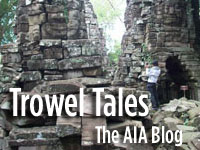A Chilling Fantasy at Tiwanaku
by Heather Pringle
June 5, 2009
Â
 Last week, while travelling in Bolivia, I spent two days at one of the New World’s most important archaeological sites, marveling at its massive, sculpted megaliths and shaking my head at the blindness of some of its early investigators. Tiwanaku, as many of you may know, was once the heart of a large and powerful Andean empire that stretched as far south as northern Argentina and Chile and reached the height of its power some 1500 years ago.   According to some modern archaeologists, Tiwanaku boasted a population as high as 50,000 people, many of whom earned their living by herding llamas and alpacas and tending fields reclaimed from lakes and swamps.Â
Last week, while travelling in Bolivia, I spent two days at one of the New World’s most important archaeological sites, marveling at its massive, sculpted megaliths and shaking my head at the blindness of some of its early investigators. Tiwanaku, as many of you may know, was once the heart of a large and powerful Andean empire that stretched as far south as northern Argentina and Chile and reached the height of its power some 1500 years ago.   According to some modern archaeologists, Tiwanaku boasted a population as high as 50,000 people, many of whom earned their living by herding llamas and alpacas and tending fields reclaimed from lakes and swamps.Â
But what most impressed 19th-century European visitors were the huge carved figurines and the massive stone ruins that sprawled over nearly 1000 acres. Ignoring the indigenous Aymara people who cultivated fields and herded livestock in the area, many of these travelers concluded that Tiwanaku was the work of foreign invaders. Francis de Castelnau, for example, proposed in the mid-19th century that Tiwanaku was the work of wandering Egyptian pharaohs, as opposed to the “imbicilic race that inhabits the country today.â€
This was not only blatantly wrong, but terribly racist. Tiwanaku was clearly born from the genius of Andean peoples. But such racist fantasies often tend to take on lives of their own, evolving in strange and ever more poisonous ways. This is certainly true of Tiwanaku, as I discovered a few years ago while researching Nazi scientific expeditions of the 1930s for my book, The Master Plan: Himmler’s Scholars and the Holocaust.  Â
My research showed that Heinrich Himmler, one of the most powerful men in the Third Reich and the head of the SS, approved and agreed to finance a large scientific expedition to Tiwanaku under the leadership of Edmund Kiss. Kiss, a German building contractor and novelist, was a fantasist.  He believed that a mythical Aryan master race, based in Atlantis, had planted a daughter colony in Bolivia more than one million years ago.  According to Kiss, these Aryan invaders  first subdued and conquered the local people, then built a great city—Tiwanaku.   Â
Kiss spent more than a year drawing up bizarre, detailed plans for the expedition: Himmler approved them. In 1939, however, the Second World War intervened and the expedition was postponed—forever, as it turned out.  But by then, Kiss had published two novels and one technical book (which Himmler had bound in leather as a Christmas gift for Adolf Hitler) on this crackpot theory.  Moreover,  Nazi magazines presented Kiss’s fantasies as if they were scientifically proven facts.
All of this may sound silly and laughable today, perhaps even harmless. But I think that it’s important to remember that these ideas were part and parcel of a massive Nazi propaganda machine intended to convince all Germans—and particularly the SS-men who guarded the concentration camps and carried out the Final Solution—that they were members of a master race whose destiny was to conquer, control and ultimately liquidate those of “inferior blood.â€
As I walked the great plazas and courtyards of Tiwanaku last week, I felt a deep chill. It wasn’t the Andean cold that bothered me. It was the ghost of Edmund Kiss.Â
Â
Comments posted here do not represent the views or policies of the Archaeological Institute of America.






 Heather Pringle is a freelance science journalist who has been writing about archaeology for more than 20 years. She is the author of Master Plan: Himmler's Scholars and the Holocaust and The Mummy Congress: Science, Obsession, and the Everlasting Dead. For more about Heather, see our
Heather Pringle is a freelance science journalist who has been writing about archaeology for more than 20 years. She is the author of Master Plan: Himmler's Scholars and the Holocaust and The Mummy Congress: Science, Obsession, and the Everlasting Dead. For more about Heather, see our 



